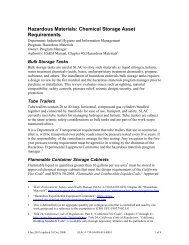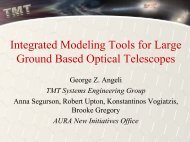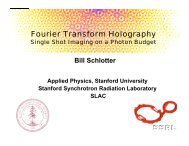BES - SLAC Group/Department Public Websites - Stanford University
BES - SLAC Group/Department Public Websites - Stanford University
BES - SLAC Group/Department Public Websites - Stanford University
You also want an ePaper? Increase the reach of your titles
YUMPU automatically turns print PDFs into web optimized ePapers that Google loves.
FYO7 <strong>SLAC</strong> S CIENCE AND T ECHNOLOGY S ELF E VALUATION<br />
G ▪ Astrophysics Program at the Kavli Institute<br />
The Kavli Institute for Particle Astrophysics and Cosmology (KIPAC) is jointly administered by<br />
<strong>SLAC</strong> and the <strong>Stanford</strong> School of Humanities and Science, with affiliations to the Physics and<br />
Applied Physics <strong>Department</strong>s. The Institute engages in theoretical, observational, and experimental<br />
research in astrophysics and technology, ranging from the structure and evolution of the universe, to<br />
the physics of compact objects, like black holes and neutron stars.<br />
During the past year, KIPAC researchers were especially productive, generating over 150<br />
publications in the professional literature (see details in the <strong>Public</strong>ations Appendix). Thomson<br />
Scientific, an organization that tracks citations to scientific publications, has determined that<br />
<strong>Stanford</strong>/<strong>SLAC</strong> had the highest percentage increase in total citations in the field of Space Science<br />
(including astronomy and astrophysics) over this period for any institution in the world.<br />
Objective 1.1 Science and Technology Results Provide Meaningful Impact on the Field<br />
Some results that attracted particular attention included the following.<br />
The demonstration that an analysis of time delays among the separate images in the strong<br />
gravitational lens, B1608+656, can be used to derive constraints on the Hubble constant<br />
that are competitive with the best available from other techniques.<br />
Analysis of a subset of highly relaxed and spherical rich clusters of galaxies, which<br />
allowed accurate constraint of the matter density of the universe. Combining these results<br />
with supernova and cosmic microwave background data gives a value of the dark energy<br />
pressure-density ratio of w = 1.01 +/- 0.09, consistent with a pure cosmological constant.<br />
Analysis of the weak lensing, strong lensing, and x-ray images of the bullet cluster, has<br />
demonstrated unambiguously that dark matter is collisionless, and can separate from the<br />
baryonic matter associated with stars and x-ray emitting hot gas. Useful constraints on the<br />
self-interaction cross section of dark matter have resulted.<br />
Observations of the blazar, Mrk 501, with the MAGIC TeV gamma-ray telescope show<br />
that the source varies on the remarkably fast timescale of two minutes. This has significant<br />
implications for physical conditions in the source. Gamma-ray Large Area Space<br />
Telescope (GLAST) observations of similar objects are guaranteed to be highly<br />
prescriptive.<br />
The HESS observation analysis of the supernova remnant J1713.7-3946 shows that this<br />
remnant appears to be accelerating protons up to energies of order 0.3 PeV. This implies<br />
that the magnetic field must be strongly amplified in the acceleration region, a result<br />
confirmed through observations of x-ray variability in this source, using the Suzaku x-ray<br />
observatory.<br />
GLAST is a satellite-based experiment to measure the cosmic gamma-ray flux in the energy range<br />
from 20 MeV to greater than 300 GeV, with supporting measurements for gamma-ray burst (GRB)<br />
transients in the energy range 10 keV to 25 MeV. With a sensitivity 30 times that of the Energetic<br />
Gamma Ray Experiment Telescope (EGRET) detector on the Compton Gammy Ray Observatory<br />
mission, GLAST will open an important window on many high-energy phenomena, including supermassive<br />
black holes and active galactic nuclei, GRBs, supernova remnants and cosmic ray<br />
acceleration, as well as searches for new phenomena. Delays in the observatory integration and test<br />
program have postponed the GLAST launch to spring 2008.<br />
The Large Area Telescope (LAT) is the primary science instrument on GLAST. The LAT<br />
collaboration joins particle physicists and high energy astrophysicists.<br />
As of September, 2007 the collaboration numbers 88 scientific members, 81 affiliated members and<br />
28 postdocs. The LAT Principal Investigator and Spokesperson is Professor Peter Michelson<br />
(<strong>Stanford</strong> and <strong>SLAC</strong>). The LAT has been developed in a partnership between NASA and the DOE,<br />
with substantial contributions from Italy, Japan, France and Sweden. The LAT project is managed at<br />
F I N A L P A G E 3 5












